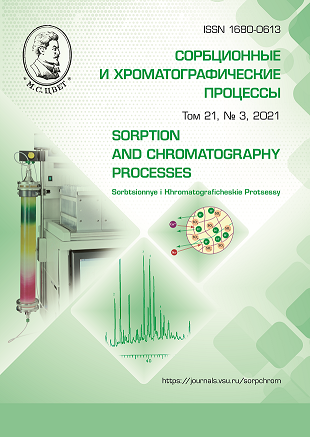Analysis of the properties of films of moleculary imprinted polymers based on polyimide
Abstract
In this study, molecularly imprinted polymers based on a copolymer of 1,2,4,5-benzene tetracarboxylic acid dianhydride with 4,4'-diaminodiphenyl oxide and a solution of preservatives (2: 1) were obtained. Study of the properties of molecularly imprinted polymer (MIP) films was performed by infrared spectroscopy and scanning probe microscopy (SPM). It was found that there were no significant differences in the IR spectra of MIP and reference polymers. This means that during the synthesis of molecularly imprinted polymers, the “ladder” structure characteristic of polyimide is retained, but the intensity of the characteristic frequencies for polymers with imprints of preservatives increases.
Analysis of the surface morphology of the films showed that the application of the prepolymerization mixture with a stamp leads to the formation of a more uniform surface (with a height difference from 1.4 to 2.6 nm) than in the case when the mixture was applied with a spatula (with heights in the range 0.9-4.0 nm). The developed method of application of the mixture by stamping allowed obtaining films with good reproducibility of thickness and surface morphology.
The comparison of SPM images of molecularly imprinted polymers and the polyimide, on the basis of which they were obtained, revealed a decrease in the number of micropores and an increase in the number of mesopores. In this case, the morphology of MIP-E202 and MIP-E211 films have significant differences associated with the features of the formation of prints of potassium sorbate and sodium benzoate.
During the synthesis of MIP-E211, a significant number of meso- and macropores were formed. Considering the small size of the sodium benzoate molecule (0.82 nm), it can be assumed that the inner surfaces of the meso- and macropores of the polymer film may contain depressions and pores (imprints) complementary to sodium benzoate molecules. In case of potassium sorbate, which has a linear structure, its molecules were located both on the surface and buried in the polymer matrix. When they were removed, prints, composing the majority of the surface and corresponded to the dimensions of ultramicro- and micropores remained.
The studies of the SPM images of the films of molecularly imprinted polymers revealed the absence of globules on their surface, which indicates the almost complete removal of template molecules during the extraction process.
Downloads
References
Nechayev A.P., Kochetkova A.A., Zaytsev A.N., Pishchevyye dobavki. M., Ko-los, Kolos-Press, 2002, 256 p.
Shazia Khanum Mirza, Asema U.K., Sayyad Sultan Kasim, Journal of Medicinal Chemistry and Drug Discovery, 2017, Vol. 02, No 02, pp. 610-616.
Trebovaniia bezopasnosti pishchevykh dobavok, aromatizatorov i tekhnolog-icheskikh vspomogatel’nykh sredstv: tekhnicheskii reglament Tamozhennogo soiuza TR TS 029/2012 of 20.07, 2012, No 58.
Abdulmumeen H.A., Risikat A.N., Suru-rah A.R., International Journal of Biological Chemistry, 2012, Vol 1, pp. 36-47.
Inetianbor J.E., Yakubu J.M., Ezeonu S.C., Asian Journal of Science and Technol-ogy, 2015, Vol 6, No 2, pp. 1118-1135.
Kumar H., Jha A., Taneja K.K., Kabra K. et al, National Journal of Community Medicine, 2013, Vol. 4, No 3, pp. 402-406.
Ree M., Stoa E., Concordia College Journal of Analytical Chemistry, 2011, Vol. 1, pp. 71-77.
Chua S.L., Teo S.S., International Jour-nal of Nutrition and Food Sciences, 2017, Vol. 2, No 4, pp. 58-64.
Maystrenko V.N., Maystrenko V.N., Khamitov R.Z. Budnikov G.K. Ekologo-analiticheskiy monitoring supertoksikantov, M., Khimiya, 1996, 319 p.
Zyablov A.N., Duvanova O.V. et al. Patent RF, No 137946, 2014.
Zyablov A.N., Duvanova O.V. et al. Patent RF, No 1138636, 2014.
Kazitsyna L.A., Kupletskaya N.B. Primeneniye UF, IK i YAMR spektroskopii v organicheskoy khimii. M., Vysshaya shkola, 1971, 264 p.
Roeges N.P.G. A guide to the complete interpretation of infrared spectra of organic structures. New York, John Wiley & Sons, 1994, 340 p.
Scanning Probe Microscopy Image Pro-cessing Software «FemtoScan Online». M. Advanced Technologies Center.
Uglyanskaya V. A. et al. Infrakrasnaya spektroskopiya ionoobmennykh materialov. Voronezh, Izdatel'stvo Voronezhskogo gosudarstvennogo universiteta. 1989, 208 p.
Silverstein R. M., Webster F. X. Spec-trometric Identification of Organic Com-pounds. New York, John Wiley & Sons. 1997, p. 326.
Tarasevich B. N. IK spektry osnovnykh klassov organicheskikh veshchestv: spravochnyye materialy. Moskva, MGU, 2012. 55 p.
Shimako N. A., Shishkina M. V. In-frakrasnyye ul'trafioletovyye spektry po-gloshcheniya aromaticheskikh efirov. Mos-kva, Nauka, 1987, 125 p.
D'yakonova O.V., Sokolova S.A., Zya-blov A.N., Zhibrova Yu.A., Sorbtsionnye i khromatograficheskie protsessy, 2007, Vol. 7, No. 5, pp. 873-877.
Zyablov A.N., Sorbtsionnyye i khroma-tograficheskiye protsessy, 2008, Vol. 8, No 1, pp. 172-175.
D'yakonova O.V., Zyablov A.N., Ko-tov V.V., Yeliseyeva T.V. et al., Sorbtsionnyye i khromatograficheskiye protsessy, 2005, Vol. 5, No 4, pp. 501-506.
D'yakonova O.V., Sokolova S.A., Zya-blov A.N., Zhibrova Yu.A., Sorbtsionnyye i khromatograficheskiye protsessy, 2008, Vol. 8, No 5, pp. 863-868.
Duvanova O.V., Volodina L.V., Zya-blov A.N., Grechkina M.V. et al., Sorbtsionnye i khromatograficheskie protsessy, 2013, Vol. 13, No 6, pp. 884-890.
Gendrikson O.D., Zherdev A.V., Dzantiyev B.B., Uspekhi biologicheskoy khimii, 2006, Vol. 46, pp. 149-192.
Dmitriyenko S.G., Irkha V.V., Duysebayeva T.B., Mikhaylik Yu.V. et al., Zhurnal analiticheskoy khimii, 2006, Vol. 61, No 1, pp. 18-23.







